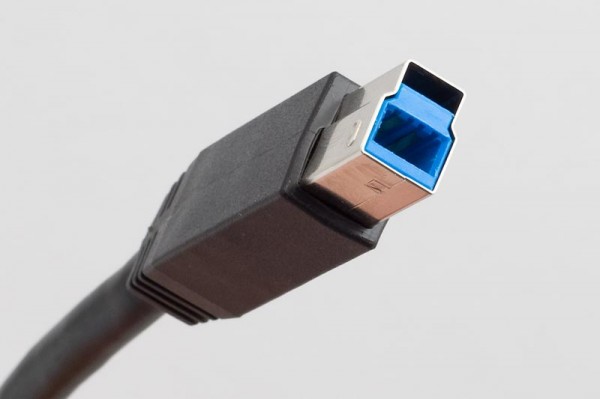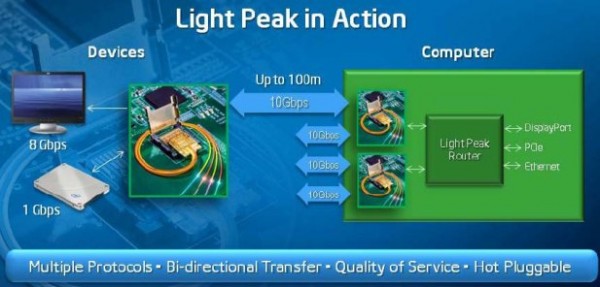All wireless! People are already tired of those entangled cables, but the year 2011 will show that cables are still important in our life. Although people in many parts of the world have swapped their Ethernet cables to the Wi-Fi; HDMI jacks and other cable connections are not dying yet.
1. USB 3.0

Transferring a DivX movie in less than two seconds, that’s the promise of USB 3.0. With a speed of 500 Mb/s, it is 10 times faster than the current USB 2.0. For consumers, the use of USB 3.0 will require compatible cables to gain maximum USB 3.0 performance. For the moment, there are only a few hard drives and perhaps SSD that support USB 3.0. Announced in 2008, this new USB version is already available in 2010, and it has not flooded the market yet.
In addition, some older motherboards can’t deliver a full 500 MB/s speed yet, because PCI Express 1.x ports can only deliver up to 250 MB/s of data throughput.
Intel will develop new chipsets that fully supports USB 3.0 technology for motherboards that have PCI-e 2.x and PCI-e 3.0 ports. These new chipsets are scheduled to arrive on the first quarter of 2011. Therefore, next year we will finally see plenty of USB 3.0 connectivity, similar to the present USB 2.0.
Transferring files to a laptop via USB port is a common thing, but the fact that USB 3.0 can accommodate 900 mA of power indicates a possibility to charge a device via USB. This will allow you to share an Internet connection with a smartphone while charging it with a USB 3.0 cable. The current USB 2.0 ports are not designed to receive electricity, but simply to distribute it.
2. Micro-USB

It is a miniaturized version of the USB port, micro-USB is already a common connectivity option in cellphones. More and more handheld devices adopt this standard to charge their batteries. And for one good reason: in 2009, the EU had obtained commitments from 10 cellphone manufacturers to adopt the micro-USB charger as a common technology. The introduction of a universal charger will make life easier for users. There’s no need to bring a special charger cable and you can potentially use charger cable manufactured by other cellphone manufacturer.
3. Intel Light Peak

It is essentially a new connection using fiber optics technology. Recently featured at the Intel Developer Forum, Light Peak is claimed to have a throughput of 10 Gbps or the ability to copy a Blu-ray movie (50GB) in just 40 seconds.
Light Peak is designated to replace all cables, including SCSI, FireWire, PCI Express, SATA, HDMI and USB. The data throughput can be divided simultaneously between the HDMI (up to 10 Gbps), USB 3.0 (5 Gb), Ethernet port (1 Gbps) and the audio system. Intel even predicts that the Light Peak can eventually reach 100 Gbps in 10 years.
4. HDBaseT

In short, it is ten times less expensive and more efficient than HDMI, because it uses standard network cables (CAT-5e and CAT-6) for data transport and CAT-5e cable costs less than a HDMI cable. For the price of a 2 meters HDMI cable, you can get 20 meters of CAT-5e cable. In addition, the HDBaseT allows efficient transfer for up to 100 meters, where the HDMI already shows some problems if the cable is more than 5 meters. In addition, HDBaseT specifications show a sufficient bandwidth to transmit a HD 1080p 3D, 4K (4096 x 2048 pixels) video stream, multichannel audio and even electricity (up to 100 Watts).
The first compatible products are expected to arrive in 2011. Samsung, Sony and LG are already in the race to support this technology. The consortium promises to support common devices such as televisions and computers. Consumers do not need to update their equipments as new plug-in adapters are already in development.
5. Wiretap
Who has never complained when seeing a huge, sleek LCD TV is ruined by the sight of those ugly black cables. You always want to better camouflage cables and remove clutters. Wiretap is a universal ribbon cable with a thickness of 0.16 mm thick, you can place it everywhere, behind the wallpaper or even paint. Once you have found the desired length, you simply need to add the appropriate connectors. With Wiretap, you can easily use small holes on the door or windows frames.










thanks for sharing useful information